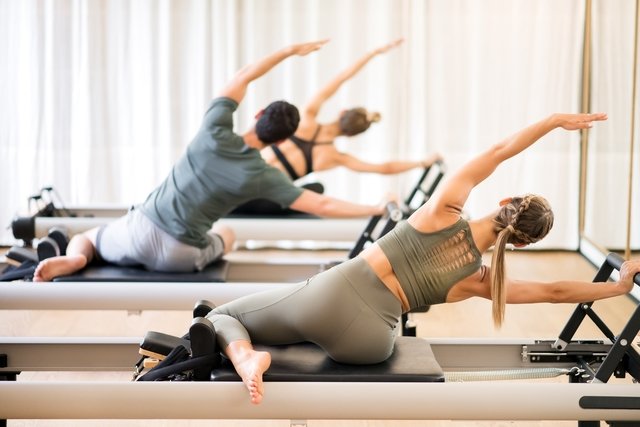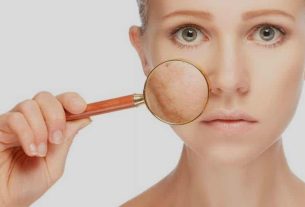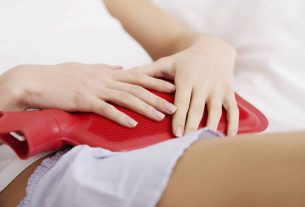Pilates is a training method that can be performed by people of all ages and can bring several health benefits, such as improving motor coordination, increasing flexibility and mobility, improving balance and posture and cardiorespiratory capacity.
The Pilates method uses techniques from different specialties, such as gymnastics, physiotherapy, ballet and yoga, using muscular strength together with mental control, breathing and relaxation.
Furthermore, to guarantee the benefits of Pilates, it is important that it is carried out under the guidance of a specialized professional, as this way it is possible to ensure that the exercises most suitable for your age and objective are performed correctly.

Benefits of pilates
Pilates, when practiced regularly and under the guidance of a physiotherapist or specialized physical education professional, can bring several health benefits, the main ones being:
The main benefits of regularly practicing Pilates are:
- Improve posture and correct incorrect postural habits;
- Increase flexibility and mobility;
- Improve motor coordination;
- Breathe better and more consciously;
- Achieve good muscle tone, strengthening and toning the body;
- Promote mental relaxation;
- Increase body awareness;
- Reduce stress and body tension;
- Increase vitality and strength;
- Help prevent and rehabilitate musculoskeletal injuries;
- Reduce tiredness and help you sleep better;
- Relieve back pain;
- Improve blood circulation and blood oxygenation.
Furthermore, Pilates can also promote muscle toning, preventing the occurrence of urinary infections in older people and pregnant women, for example, in addition to helping to relieve stress and increase mood and concentration.
How to make
Pilates exercises can be performed on the floor, using your own body weight, or using equipment, such as weights, springs, balls or specific Pilates equipment, depending on the objective of the exercises and in accordance with the guidance of the professional.
It is recommended that Pilates be practiced regularly, as this way it is possible to guarantee the benefits and promote quality of life.
Read too: Pilates on the wall: what it is, what it’s for (and how to do it)
When is indicated
Pilates is suitable for everyone, whether children or the elderly, as the exercises are adapted for each stage of life and goals. In the case of children and adolescents, Pilates is mainly indicated to improve posture and flexibility, contributing to healthier growth and development, preventing future injuries as adults.
In adults, Pilates can be performed with several benefits, such as improving physical condition and general health, toning the body, strengthening internal muscles, increasing physical and mental energy, improving circulation and flexibility and reducing stress.
In the case of the elderly, Pilates is usually indicated to maintain and/or improve flexibility, improve breathing, increase mobility, coordination and balance, being useful for preventing falls and fractures, relieving back pain, improving joints and strengthen the body.
Furthermore, Pilates exercises can be recommended to regain mobility after trauma, such as fractured bones, muscle dislocation, back pain, such as low back pain.
Pilates principles
Pilates is based on 6 principles:.
- Center of force: also called “power center”, since all the energy needed to perform the exercises is generated from the center of the body, coordinating all movements in a balanced way;
- Concentration: it is essential to connect the mind and body, pay attention and be aware of the movements that are performed and the muscles that are contracted and relaxed, to work the body effectively and thus obtain its benefits;
- Control: this principle is important to avoid sudden, irregular and causal movements and, thus, prevent injuries and promote the benefits of the practice;
- Fluidity: In the Pilates method there are no static or isolated movements, they are dynamic and fluid;
- Precision: it is important to maintain focus to perform each movement precisely, which is necessary for the exercise in its entirety to be performed correctly, maintaining good posture to prevent injuries and, thus, obtain the desired results;
- Breathing: It is essential to learn how to breathe correctly to help with concentration, control movements and obtain greater lung capacity and blood circulation.
All these principles are fundamental for Pilates to be practiced in the best way and, therefore, to guarantee several benefits.
Bibliography
- BROOKE SILER. The pilates method. Exclusive distribution: Ediciones Paidós Ibérica, SA Mariano Cubí 92 – 08021 Barcelona – Spain Editorial Paidós, SALCP. Defensa 599 – 1065 Buenos Aires – Argentina Editorial Paidós Mexicana, S., 2000.
- FERNANDEZ-RODRIGUEZ, Ruben; ALVAREZ-BUENO, Celia; FERRI-MORALES, Assuncion et al. Pilates Method Improves Cardiorespiratory Fitness: A Systematic Review and Meta-Analysis. J. Clin. With. Vol 8. 2019
- GOEDERT, Araceli; SANTOS, Karini B.; BENTO, Paulo Cesar B.; RODACKI, André Luiz F. The effect of Pilates practice on balance in elderly: a systematic review. Rev Bras Ativ Fís Saúde. Vol 23. 2018
- JUNIOR, Jordan RM; GOMES, Jorge Luir B.; GOMES, José Paulo et al. Hemodynamic responses during and after pilates session compared to aerobic and resistance exercise. Rev Bras Ativ Fis Saúde. Vol 19. 6 ed; 732-743, 2014

Sign up for our newsletter and stay up to date with exclusive news
that can transform your routine!
Warning: Undefined array key "title" in /home/storelat/public_html/wp-content/plugins/link-whisper-premium/templates/frontend/related-posts.php on line 12
Warning: Undefined array key "title_tag" in /home/storelat/public_html/wp-content/plugins/link-whisper-premium/templates/frontend/related-posts.php on line 13




